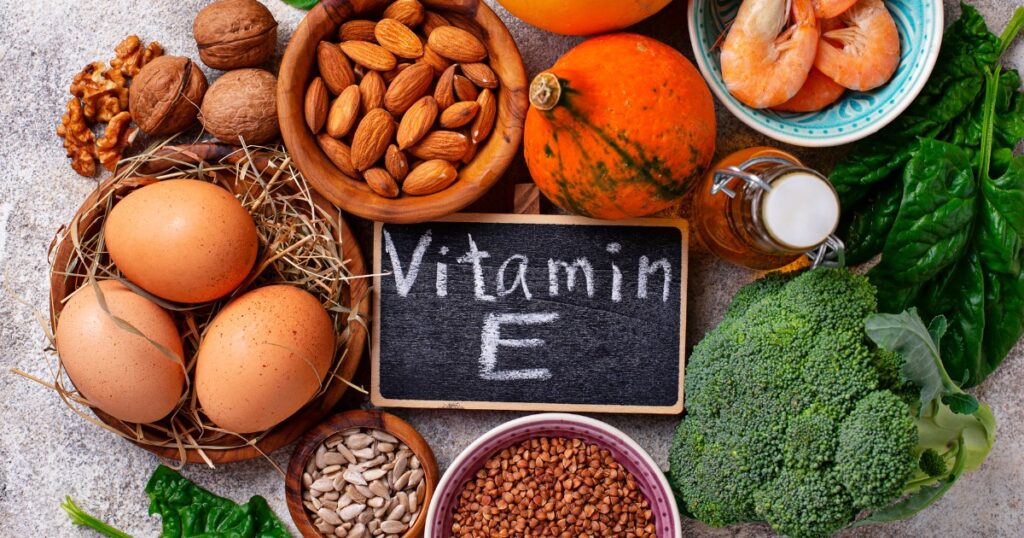
Vitamin E: Introduction
Even though vitamin E has been recognized since 1922 as a necessary component for reproduction, our knowledge of the physiological mechanisms underlying its actions is still very limited. A class of tocopherols and tocotrienols known as vitamin E is comprised of α-tocopherol, which has the highest biological activity.Owing to tocopherols’ strong antioxidant qualities, studies on the role of α-tocopherol in preventing chronic illnesses linked to oxidative stress have been conducted frequently, with positive results shown. According to recent observations, α-tocopherol has signaling functions in vascular smooth muscle cells that other forms of tocopherol with similar antioxidative properties cannot exert, and the liver’s α-tocopherol transfer protein specifically separates RRR-α-tocopherol from all incoming tocopherols for incorporation into plasma lipoproteins.Considering that alternative forms of tocopherol with similar antioxidative qualities cannot perform the same signaling functions in vascular smooth muscle cells as α-tocopherol, have sparked interest in the responsibilities of vitamin E beyond its antioxidative function.
Different Metabolic Problems:
Contributor vitamin E (VE) is one well-known important function it plays in shielding cell components from oxidative damage. VE’s health benefits appear to be more broader than those of an antioxidant acting in lipophilic environments, according to the evidence.
The fact that VE is directed toward pathways involving lipoproteins and cholesterol in humans emphasizes the importance of VE in the processing and metabolism of lipids. This means that in physiopathological situations linked to disruptions in lipid metabolism or concurrent with oxidative stress, like obesity, both VE intake and status may be significant.
Since VE in humans is misdirected into pathways that deal with lipoproteins and cholesterol, it is important for lipid management and metabolism. This suggests that VE status and consumption may be significant in physiopathological illnesses such as obesity that coexist with oxidative stress or are associated with abnormalities in lipid metabolism.
However, the results of research utilizing VE supplements are not always trustworthy, and there are currently no established dietary reference values for VE in obese individuals.
Therefore, a better understanding of the role of genetic differences in genes linked to VE metabolism may be crucial to more accurately enforce dietary recommendations.Although there is not enough information currently available to make definitive conclusions, genetic differences associated with poor VE hepatic balance and the control or resolution of oxidative stress may also be significant.
Effect Of Vitamin ‘E’and Uses Of Vitamin ‘E’ In Treating Different Diseases:
Its antioxidant action allows it to play a variety of vital roles in the body. Numerous potential illnesses and ailments, including as cancer, aging, arthritis, and cataracts, have been related to oxidation; vitamin E has been demonstrated to be beneficial against these.
Blood Pressure:
Heart rate changed by -4.3% in DG and -14.0% in PG (p < 0.05). The study concludes that moderate hypertension patients may benefit over time from a 200 IU daily vitamin E supplement, most likely as a result of nitric oxide, since it will improve their blood pressure.
Heart Attack:
Numerous investigations have assessed the protective properties of vitamin E against or as a therapy for coronary artery disease (CAD). According to in vitro research, vitamin E prevents low-density lipoprotein from oxidizing and lessens the amount of atherogenic oxidized low-density lipoprotein that builds up in artery walls.
Liver Disease:
Apart from its antioxidant properties, certain research works suggest that vitamin E enhances the integrity of the liver by inhibiting the hepatic cluster of differentiation 36 protein (CD36), which is a membrane transporter that facilitates the absorption of fatty acids into the liver.
Cancer:
Removes reactive oxygen species, stop tumor development and carcinogenesis, and promote the death of cancer cells.
Vitamin E can prevent cancer when consumed through food or supplements high in γ- and δ-tocopherols. However, high-dose α-tocopherol supplementation does not have this effect.
Atherosclerosis:
Vitamin E may be added to food to stop LDL oxidation and associated cytotoxicity, which would stop atherosclerosis from developing and lower the risk of CVDs [24, 25].
Cataract:
By lowering photoperoxidation of lens lipids and stabilizing lens cell membranes, vitamin E, a lipid-soluble antioxidant that is abundant in lens fibers and membranes, may prevent the development of cataracts
Arthritis:
Due to its ability to stimulate cartilage cell formation, vitamin E may be able to treat. Research conducted on cells revealed that vitamin E reduced oxidative stress caused by mechanical stress or free radicals in chondrocyte cultures or cartilage explants.
Diabetes:
However, we discovered in subgroup analyses that vitamin E intake in studies with a <10 week intervention period significantly lowered fasting blood glucose. Finally, it can be said that vitamin E consumption helps lower insulin resistance and improve HbA1c in the patients. Additionally, these patients have decreased fasting blood glucose after receiving brief vitamin E therapies.
Conclusion:
In Canada, vitamin E was initially used as a supplement by doctors Shute and Shute, who started utilizing it on a regular basis in their offices after seeing the favorable effects of it. Ever since, a number of well planned experimental and clinical investigations have advanced and deepened our understanding of vitamin E. Research has shown that vitamin E’s antioxidant qualities are essential in the fight against a number of illnesses, including AD, cataracts, cancer, oxidative stress, and atherosclerosis.
To Get More information:
- Visit: https://pinnacleihm.com
- Phone No:+91 92465 28830 | +91 98665 38830
- Email: info@pinnacleihm.com
- Address:#12-1-59/NR, Goods Shed Road,Behind Registration Office, Moosapet, Hyderabad-500018
- Maps: Pinnacle Institute of Hotel Management & Catering Technology
